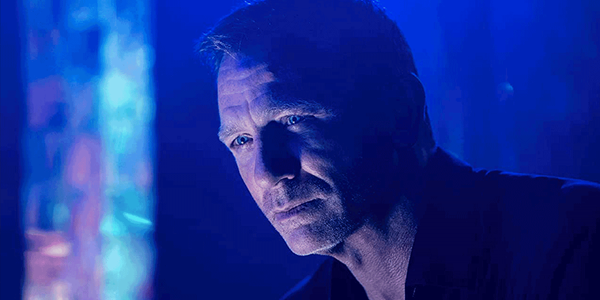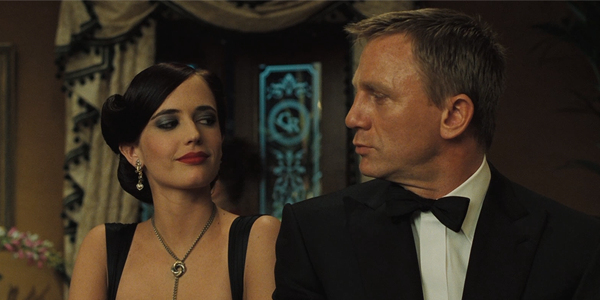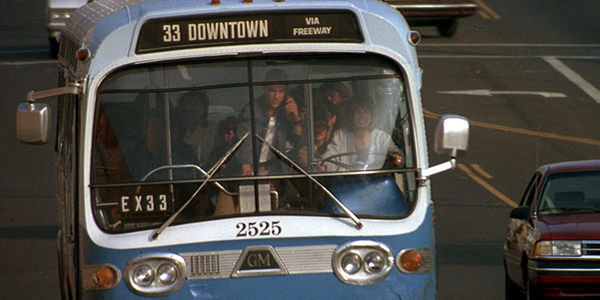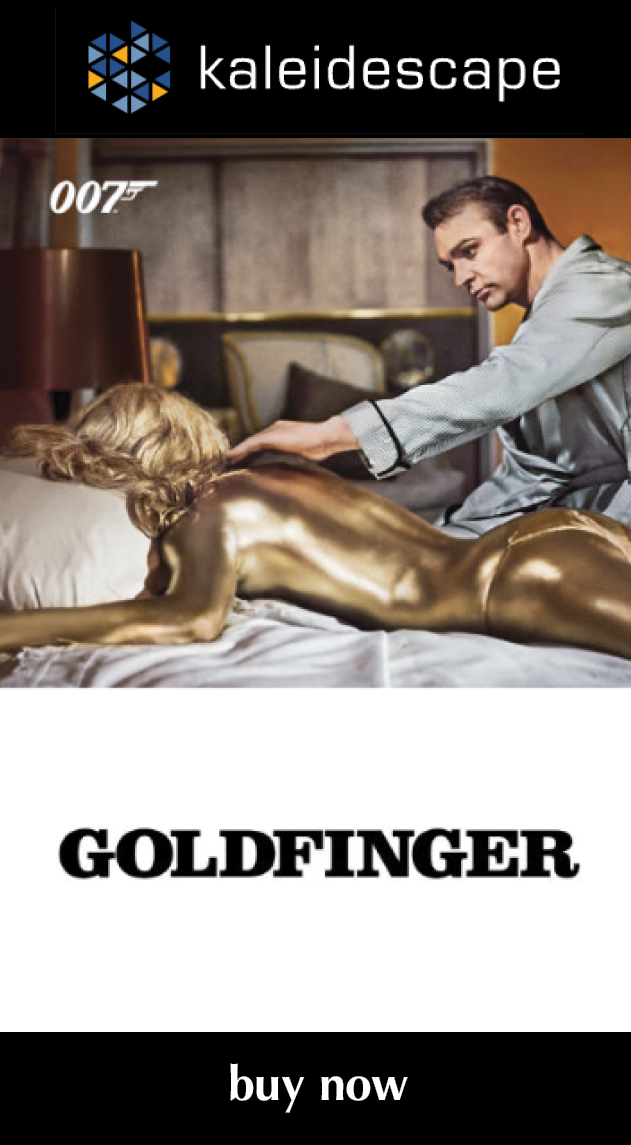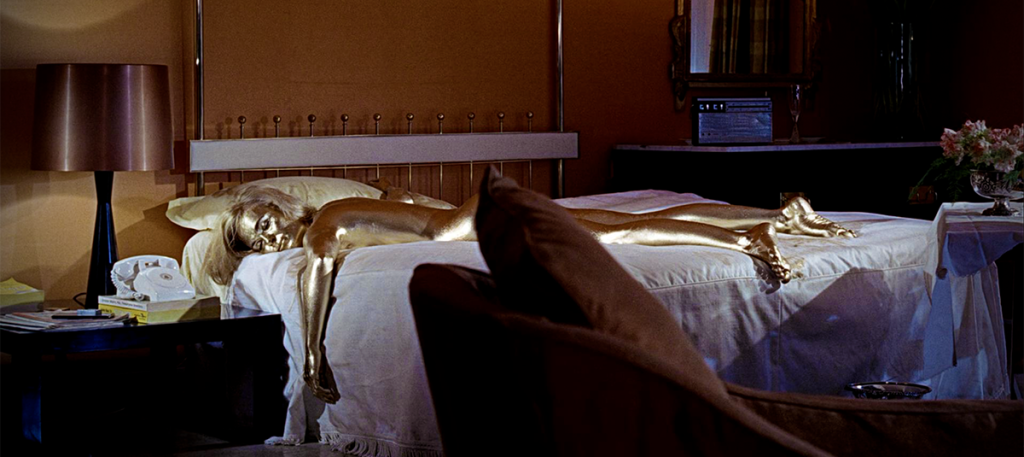
review | Goldfinger
The most iconic of the Bond films shows little of its age in this 4K transfer
by John Sciacca
April 7, 2020
“The name’s Bond. James Bond.” There is perhaps no more iconic introduction catchphrase in the history of cinema, a line cribbed and lampooned countless times in nearly as many different genres.
Say “James Bond” and it immediately conjures a host of similar images in people’s minds. Bond, ever cool under pressure, gliding through a world inhabited by fast women and faster cars, pitted against ruthless super-villains bent on world domination. Bond, always perfectly attired, knowing the right thing to say or do in any situation, doing whatever necessary to complete the assignment at hand regardless the risk, saving the world and leaving with the girl.
Bond is the original man men wish they could be, and women wish they could be with. While Ian Fleming’s Bond was a popular character in literary fiction—actually mentioned by President Kennedy as one of favorite books, leading to From Russia With Love to be the second film made—it wasn’t until Bond hit the big screen with Dr. No in 1962 that he truly caught on and hit worldwide acclaim.
I came to Bond through my father, and I can remember watching the latest Bond adventure when it would hit TV, gaping at the opening title sequences as each film revealed more and more inches of female skin, and wondering what incredible gadget the super spy would have up his sleeve (quite literally in the case of the Rolex Submariner he wore in many of the early films).
My dad, who read all the Fleming (and subsequent John Gardner and Raymond Benson) books, was a Sean Connery man, faithful to the original. And while Bond is now entrenched in the world’s zeitgeist, it’s likely there would be no Bond today had the casting fallen short with that first film.
Bond needed to be able to handle himself physically, but not be so big that he stood out. With a weightlifting and boxing background, and a 6-foot 2-inch height, Connery fit the bill. He also needed to have enough style and charm that he could fit in playing baccarat with billionaires in Monte Carlo or be believable driving around in an Aston Martin with a beauty at his side, but also be equally at home getting his hands dirty when the time called for it. Connery’s Bond oozed confidence and cool, and he wore the character like a second skin, setting the benchmark against which all future Bonds would be judged. And launching a franchise character who has now survived 26 films by a variety of actors and spanning seven decades.
Goldfinger comes to us renewed in 4K resolution, looking impossibly clean and fresh for a film that is now 56 years old. A final credits screen displays “Pristine Digital Restoration by Lowery Digital Images, a DTS company.” Lowery Digital won the right to restore the Bond films for Blu-ray back in 2004, and the company did significant work on the films at that time, restoring damage, doing digital cleanup, and making a 4K scan of each frame. It’s likely that these are the scans taken at that time, and also why we don’t have versions of these early films featuring HDR.
Today, the Bond opening title sequences are mini features of their own, and Goldfinger is the first Bond film to really push the opening to be something more than just a song and credits. While the title sequence is incredibly tame by modern standards, with just clips from the film projected onto shimmering gold-colored models while Shirley Bassey belts out the title track letting you know beyond any question that Goldfinger loves only gold, it was the first step that got us to where we are today.
The first thing you notice about Goldfinger is that it’s presented in a slightly odd (albeit the original theatrical) aspect ratio of 1.66:1. When accurately presented, this will not quite fill a 16:9 display, with small black pillarbox bars to the left and right of the image.
The next thing you notice is how clean images look. It is as if they polished off years of grime and neglect from a window, giving you a startling glimpse into what the cinematographer saw through the lens over 50 years ago. Closeups are startlingly sharp and detailed, with edges in razor-sharp focus. Any scene where the camera pulls in tight reveals tons of micro detail and texture, whether in clothing, faces, playing cards, or building details. You can actually see the dirt under Q’s (Desmond Llewelyn) fingernails. There are also plenty of opportunities to appreciate the varieties of fabric in Bond’s suits or see the sharp and jaggie-free lines in the vertical stripes of Felix Leiter’s (Cec Linder) seersucker hat.
Colors pop, especially in bright outdoor scenes. There is a shot of a helicopter panning over a hotel and pool in Miami that dazzles with bright gleaming whites and tons of appropriate bikini-clad skin tones, and gold shimmer with appropriate luster, whether in bars or in the paint covering Jill Masterson’s (Shirley Eaton) body.
Blacks are nice and dark, and noise-free. A shot with Bond in a tuxedo clearly shows the different shade and sheen of his lapels compared to the jacket.
Not everything is perfect here, though, as the razor-sharp focus reveals the limitations of some of the technology at the time. For example, many of the shots around the pool where Auric Goldfinger (Gert Frobe) is playing cards are so crisp, the blurred backgrounds look to be obvious backdrops. The same effect is visible again when Bond is driving Tilly Masterson (Tania Mallet) around Switzerland in the famous Aston Martin DB5. And while closeups look tack-sharp, longer shots often don’t fare nearly so well. The famous scene where Bond is strapped to the laser cutting table—“Do you expect me to talk?” “No, Mr. Bond. I expect you to die!”—jarringly cuts back and forth, with the far shots looking much softer, almost like a completely different film.
Also, the opening sequence when Bond is coming out of the water in his scuba suit has an odd frame speed up where he appears to move in double speed for a second. On first viewing, I thought perhaps I’d imagined it, but it’s definitely there and clearly a speed shift. This isn’t unique to the Kaleidescape download so it’s something from the source material, perhaps due to damage or lost elements.
Sonically, Goldfinger comes with a 5.1 DTS-HD Master soundtrack but as the original film included a mono soundmix, you can’t expect too much from this. And, well, it doesn’t deliver much in the way of actual surround sound. The film is primarily spread across the front three channels, with little bass activity even during explosions. Gunshots have some nice dynamics but a modern soundmix this isn’t. Even still, dialogue is well presented and every word is easily understood, and we also get some nice atmosphere, such as the audio inside the cavernous Fort Knox at the end or Oddjob’s (Harold Sakata) hat sailing past.
As mentioned, Goldfinger isn’t the first or even second Bond film but rather the third, and is actually the seventh novel in Fleming’s series. But by this point in both the film and literary world, Bond was truly hitting his stride. He was established as the world’s greatest secret agent, helped by a Q-Branch producing high-tech gadgets in the form of one of the most iconic vehicles ever committed to film, with Connery starting to lighten up with some quips—“Shocking. Positively shocking,” after electrocuting a baddie in a bathtub—with perhaps the most on-the-nose Bond Girl name ever in Pussy Galore (Honor Blackman), and producing one of the most memorable villains in the series. The film scored a franchise high critics rating of 98% on Rotten Tomatoes as well as tying the franchise-high audience rating of 89%, and it comes to the home looking as good as you’ve ever seen it.
Probably the most experienced writer on custom installation in the industry, John Sciacca is co-owner of Custom Theater & Audio in Murrells Inlet, South Carolina, & is known for his writing for such publications as Residential Systems and Sound & Vision. Follow him on Twitter at @SciaccaTweets and at johnsciacca.com.
© 2025 Cineluxe LLC


